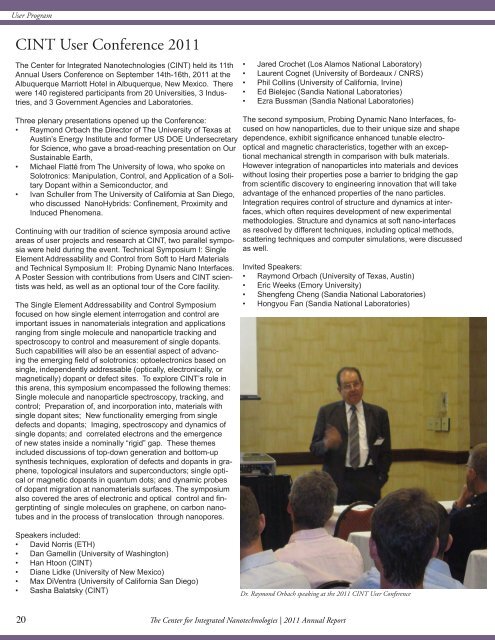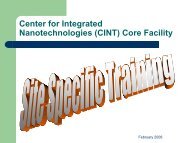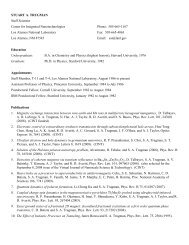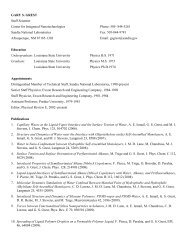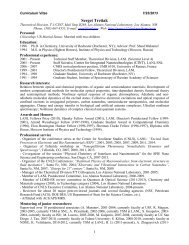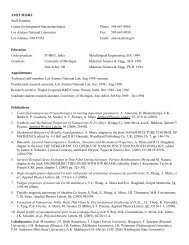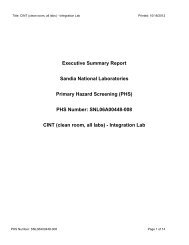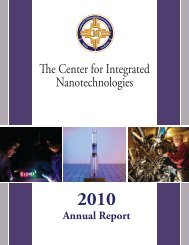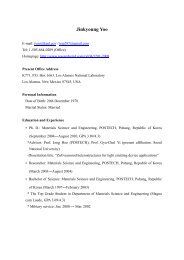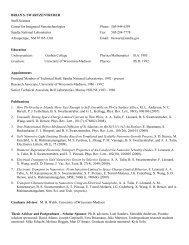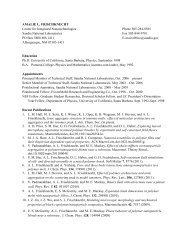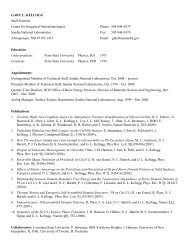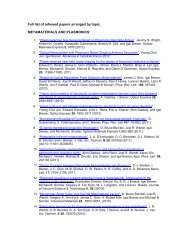2011 Annual Report - Center for Integrated Nanotechnologies - Los ...
2011 Annual Report - Center for Integrated Nanotechnologies - Los ...
2011 Annual Report - Center for Integrated Nanotechnologies - Los ...
Create successful ePaper yourself
Turn your PDF publications into a flip-book with our unique Google optimized e-Paper software.
User Program<br />
CINT User Conference <strong>2011</strong><br />
The <strong>Center</strong> <strong>for</strong> <strong>Integrated</strong> <strong>Nanotechnologies</strong> (CINT) held its 11th<br />
<strong>Annual</strong> Users Conference on September 14th-16th, <strong>2011</strong> at the<br />
Albuquerque Marriott Hotel in Albuquerque, New Mexico. There<br />
were 140 registered participants from 20 Universities, 3 Industries,<br />
and 3 Government Agencies and Laboratories.<br />
• Jared Crochet (<strong>Los</strong> Alamos National Laboratory)<br />
• Laurent Cognet (University of Bordeaux / CNRS)<br />
• Phil Collins (University of Cali<strong>for</strong>nia, Irvine)<br />
• Ed Bielejec (Sandia National Laboratories)<br />
• Ezra Bussman (Sandia National Laboratories)<br />
Three plenary presentations opened up the Conference:<br />
• Raymond Orbach the Director of The University of Texas at<br />
Austin’s Energy Institute and <strong>for</strong>mer US DOE Undersecretary<br />
<strong>for</strong> Science, who gave a broad-reaching presentation on Our<br />
Sustainable Earth,<br />
• Michael Flatté from The University of Iowa, who spoke on<br />
Solotronics: Manipulation, Control, and Application of a Solitary<br />
Dopant within a Semiconductor, and<br />
• Ivan Schuller from The University of Cali<strong>for</strong>nia at San Diego,<br />
who discussed NanoHybrids: Confinement, Proximity and<br />
Induced Phenomena.<br />
Continuing with our tradition of science symposia around active<br />
areas of user projects and research at CINT, two parallel symposia<br />
were held during the event. Technical Symposium I: Single<br />
Element Addressability and Control from Soft to Hard Materials<br />
and Technical Symposium II: Probing Dynamic Nano Interfaces.<br />
A Poster Session with contributions from Users and CINT scientists<br />
was held, as well as an optional tour of the Core facility.<br />
The Single Element Addressability and Control Symposium<br />
focused on how single element interrogation and control are<br />
important issues in nanomaterials integration and applications<br />
ranging from single molecule and nanoparticle tracking and<br />
spectroscopy to control and measurement of single dopants.<br />
Such capabilities will also be an essential aspect of advancing<br />
the emerging field of solotronics: optoelectronics based on<br />
single, independently addressable (optically, electronically, or<br />
magnetically) dopant or defect sites. To explore CINT’s role in<br />
this arena, this symposium encompassed the following themes:<br />
Single molecule and nanoparticle spectroscopy, tracking, and<br />
control; Preparation of, and incorporation into, materials with<br />
single dopant sites; New functionality emerging from single<br />
defects and dopants; Imaging, spectroscopy and dynamics of<br />
single dopants; and correlated electrons and the emergence<br />
of new states inside a nominally “rigid” gap. These themes<br />
included discussions of top-down generation and bottom-up<br />
synthesis techniques, exploration of defects and dopants in graphene,<br />
topological insulators and superconductors; single optical<br />
or magnetic dopants in quantum dots; and dynamic probes<br />
of dopant migration at nanomaterials surfaces. The symposium<br />
also covered the ares of electronic and optical control and fingerptinting<br />
of single molecules on graphene, on carbon nanotubes<br />
and in the process of translocation through nanopores.<br />
The second symposium, Probing Dynamic Nano Interfaces, focused<br />
on how nanoparticles, due to their unique size and shape<br />
dependence, exhibit significance enhanced tunable electrooptical<br />
and magnetic characteristics, together with an exceptional<br />
mechanical strength in comparison with bulk materials.<br />
However integration of nanoparticles into materials and devices<br />
without losing their properties pose a barrier to bridging the gap<br />
from scientific discovery to engineering innovation that will take<br />
advantage of the enhanced properties of the nano particles.<br />
Integration requires control of structure and dynamics at interfaces,<br />
which often requires development of new experimental<br />
methodologies. Structure and dynamics at soft nano-interfaces<br />
as resolved by different techniques, including optical methods,<br />
scattering techniques and computer simulations, were discussed<br />
as well.<br />
Invited Speakers:<br />
• Raymond Orbach (University of Texas, Austin)<br />
• Eric Weeks (Emory University)<br />
• Shengfeng Cheng (Sandia National Laboratories)<br />
• Hongyou Fan (Sandia National Laboratories)<br />
Speakers included:<br />
• David Norris (ETH)<br />
• Dan Gamellin (University of Washington)<br />
• Han Htoon (CINT)<br />
• Diane Lidke (University of New Mexico)<br />
• Max DiVentra (University of Cali<strong>for</strong>nia San Diego)<br />
• Sasha Balatsky (CINT)<br />
Dr. Raymond Orbach speaking at the <strong>2011</strong> CINT User Conference<br />
20<br />
20The <strong>Center</strong> <strong>for</strong> <strong>Integrated</strong> <strong>Nanotechnologies</strong> | <strong>2011</strong> <strong>Annual</strong> <strong>Report</strong>


